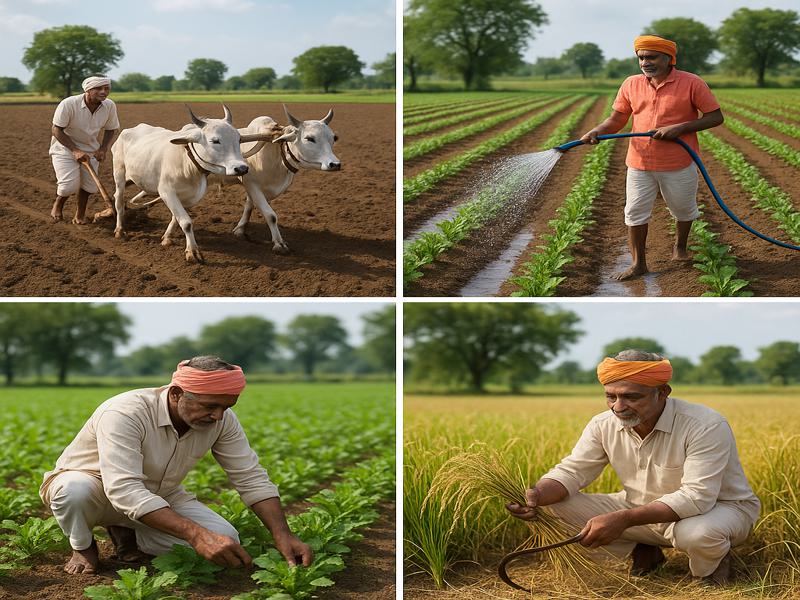Essential Practices

Essential Practices: A Guide to Better Yields and Sustainable Farming
India is a land of agriculture, with millions of farmers contributing to the nation’s food supply and economy. In this vast and diverse agricultural landscape, adopting the right farming practices is not just about tradition—it’s essential for survival, productivity, and sustainability.
In this blog post, we dive deep into the essential practices for Indian farmers, focusing on four core areas: Ploughing and Sowing, Irrigation Methods, Weed Control, and Harvesting Techniques. These practices are vital for any farmer—whether they work on a small patch of land or a larger commercial farm.
1. Ploughing and Sowing – The Foundation of a Good Crop
Ploughing and sowing are the first steps in the cultivation process, and they lay the foundation for a healthy crop cycle. If done right, they ensure the soil is prepared well for seed germination and growth.
Why Ploughing is Essential
Ploughing breaks up the soil, making it airy and soft. This helps the roots of crops penetrate easily and absorb nutrients. Traditional ploughing methods in India involve wooden or iron ploughs pulled by bullocks, while modern methods use tractors and rotary tillers.
Benefits of ploughing:
- Improves soil aeration
- Enhances moisture retention
- Helps in mixing organic matter and fertilizers
- Destroys harmful weeds and pests living in the topsoil
Right Techniques of Sowing
After ploughing, sowing the seeds at the correct depth and spacing is equally important. In India, the following sowing methods are widely used:
- Broadcasting: Scattering seeds by hand; common in small farms
- Drilling: Using tools or machines to place seeds at uniform depth
- Dibbling: Placing seeds manually in holes at set intervals
Proper sowing ensures even crop growth and reduces the competition for water and nutrients among plants.
2. Irrigation Methods – Watering the Roots of Indian Agriculture
Water management is one of the biggest challenges in Indian farming. With erratic monsoons and depleting groundwater, the need for efficient irrigation methods has never been more critical.
Traditional vs Modern Irrigation
Traditional methods like canal systems, wells, and tanks are still used in rural areas, but they often lead to water wastage.
Modern irrigation methods offer better water use efficiency:
a) Drip Irrigation
This method delivers water directly to the roots using a network of pipes. It reduces evaporation and is ideal for orchards, vegetables, and row crops.
b) Sprinkler Irrigation
Water is sprayed over crops like rainfall using sprinkler heads. It works well in uneven land and sandy soils.
c) Furrow and Basin Irrigation
Common in sugarcane and paddy fields, these methods involve controlled flooding of furrows or basins around plants.
Best Practices for Efficient Irrigation
- Use soil moisture sensors to avoid over-irrigation
- Adopt rainwater harvesting to recharge groundwater
- Implement micro-irrigation subsidies from government schemes like PMKSY
3. Weed Control – Winning the War Against Unwanted Growth
Weeds are unwanted plants that compete with crops for sunlight, water, and nutrients. If not managed properly, weeds can reduce yields by 20-40%.
Manual and Mechanical Weed Control
In small farms, manual weeding using hands or sickles is common. Though labor-intensive, it is eco-friendly and cost-effective.
Mechanical weeders and rotary weeders are used in medium to large farms. They save time and reduce labor dependency.
Chemical Weed Control
Herbicides are chemical substances used to kill weeds. They are classified into:
- Pre-emergence herbicides: Applied before weed seeds germinate
- Post-emergence herbicides: Applied after weeds grow
While herbicides are effective, farmers should:
- Use recommended doses
- Follow safety precautions
- Rotate herbicide types to prevent resistance
Organic Weed Control Practices
For sustainable farming, many Indian farmers are returning to organic weed management, which includes:
- Mulching with straw or plastic
- Cover cropping to suppress weed growth
- Using bio-herbicides like vinegar or clove oil
4. Harvesting Techniques – Timing it Right for Maximum Gains
Harvesting is the final yet most rewarding stage of farming. The timing and method of harvesting impact both yield quantity and quality.
When to Harvest?
The ideal harvesting time depends on the crop type and climatic conditions. Delayed harvesting can lead to grain shattering, fungal infections, or over-ripening.
Some common signs that indicate it’s time to harvest:
- Wheat and rice: Yellowing of leaves and hardening of grains
- Sugarcane: Sugar recovery is at peak when cane shows maturity rings
- Vegetables: Size, color, and firmness are key indicators
Methods of Harvesting
- Manual harvesting: Still widely used in India using sickles or knives
- Mechanical harvesters: Combine harvesters, reapers, and threshers are used in large-scale farming
Post-Harvest Management
Good post-harvest handling prevents spoilage and improves market value. Key steps include:
- Cleaning and drying to remove moisture and dirt
- Grading to sort produce based on size and quality
- Storage in moisture-proof godowns or silos
- Packaging for safe transport to markets or mandis
Final Thoughts: A Smarter Future for Indian Farmers
Indian agriculture is evolving. To remain competitive and profitable, farmers must adopt modern yet practical farming practices. Whether it is precision sowing, efficient irrigation, smart weed control, or timely harvesting, each step plays a crucial role in the journey from seed to market.
Government initiatives, access to technology, and knowledge-sharing platforms are making it easier for farmers to learn and implement these practices.
Key Takeaways
✅ Always start with proper ploughing and sowing for better root growth
✅ Choose irrigation methods based on your crop, soil, and water availability
✅ Apply integrated weed control using manual, chemical, and organic methods
✅ Focus on timely harvesting and safe post-harvest storage to reduce losses
By following these essential practices, Indian farmers can ensure higher yields, lower input costs, and sustainable farming—a win for both the farmer and the planet.
